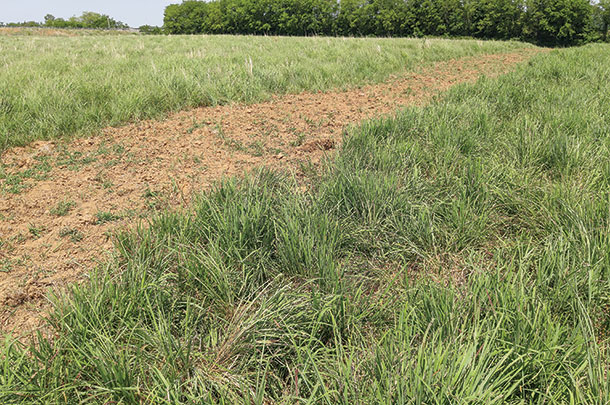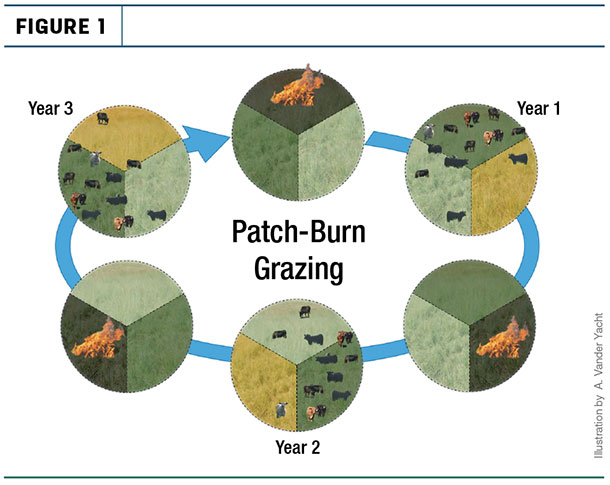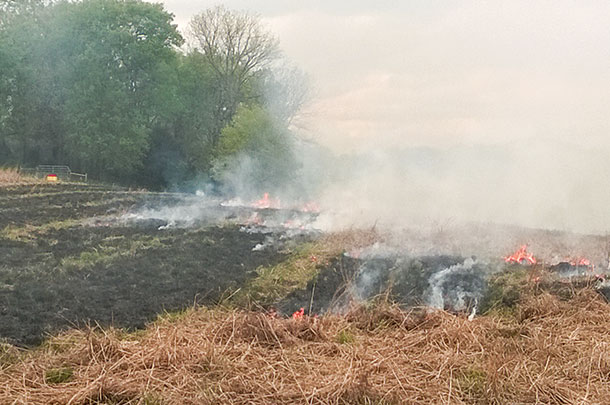They called it “patch-burn grazing.” While for most of us this is a novel approach to managing pastures, I suspect Plains tribes such as the Osage and Comanche considered it commonplace, as they set fires to improve range for buffalo and other large herbivores that provided their food. Maybe we have simply rediscovered what they have long since forgotten.
Patch-burn grazing is based on the fact that cattle will selectively graze portions of pastures that have been recently burned (Photo 1). Stockmen in range country and in the South have known this for years and have often used burning to manage pastures.

However, the benefit of the fire lasts only for a couple of months in terms of forage quality.
Other benefits (reduced brush encroachment, less old thatch, species composition) can last longer. Consequently, cattle graze patches burned the previous year somewhat less and graze areas burned more than two years previously the least. This selective grazing of the burned “patches” gives the approach its name.
But the grazing also impacts how grass develops following fire. Patches grazed heavily the year of the burn end up remaining short (and tender) and a number of broadleaf species are able to grow on the site. Conversely, those that are grazed the least (two or more years post-burning) develop a heavier growth of dominant perennial grasses, are less palatable and, thus, are grazed less (Figure 1).

Inherent in this approach is a degree of rest for patches with greater intervals since burning. Rest is important for most grass species, certainly for tall growing natives such as big bluestem and indiangrass that thrive under this type of management. While these species are grazed quite heavily the year of the burn, in subsequent years, especially the third growing season following the burn, they get ample rest due to the lighter grazing pressure.
In addition to a built-in rest cycle that helps maintain good stand vigor, patch-burn grazing has a number of other benefits. The natural movement and distribution of cattle in a patch-burn grazed pasture can be a suitable substitute for rotational grazing. As suggested above, cattle spend a disproportionate amount of their time on the current year’s burn.
Thus, the burn itself distributes grazing pressure. By not having to rotate cattle, you eliminate the need for cross-fencing or temporary fencing in that pasture. Too, you can get by with greater flexibility in locations of water and mineral sources given that cattle have complete access to the entire pasture at all times.
Another important benefit of patch-burn grazing is that you create several patches within a pasture, each with differing sward structure and composition that result from the interaction of grazing and fire. This increase in patchiness, or heterogeneity, pays dividends in terms of wildlife response.
A number of insect species important to the food web, pest control and healthy grasslands respond favorably to this type of management. The same is true for grassland birds such as meadowlarks and bobwhite quail, both of which have experienced substantial, protracted population declines. For instance, bobwhites have declined by nearly 85 percent over the past four-plus decades.
In 2013, we started a project at the University of Tennessee to see if the lessons learned in Oklahoma could apply here in the tall fescue belt. Our pasture size is much smaller than out on the Plains – and is typically less than 25 acres.
Working with partners at the University of Kentucky, the Natural Resources Conservation Service and others, we established 14, 25-acre big bluestem/indiangrass/little bluestem blend pastures. We initiated our first burns and subsequent grazing in 2015 and have continued the project in 2016. Although we no longer have funding for this work, we hope to be able to continue the project through 2017.
Despite a good deal of healthy skepticism about whether this would work here in the mid-South, it appears that even at the scale of a 25-acre pasture, cattle seem to have read the research reports. We have seen obvious selection based on burning and clear differences in canopy height within the patches.
On the other hand, we have also seen results depend on a couple of factors: First, the timing of stocking following the burn makes a difference in cattle selectivity. The longer you wait after burning, the less difference there will be in palatability and quality between the burned and unburned patches.
Second, the heavier you stock, the less selectivity cattle will have and the more uniform the grazing among patches. So quicker and lighter stocking will maximize the selectivity on burned patches.
Both here in the mid-South and in the Plains, the studies are showing that cattle rates of gain and stocking are comparable between more traditional management and patch-burn grazing. At first, this may seem like a failure for the patch-burn approach.
On the other hand, what we think it really is telling us is that there is no penalty for using this novel approach to pasture management. Rather, we are trading having to implement an annual spring burn on about one-third of a given pasture for having to install or maintain cross-fencing and having to move cattle on a regular basis. And in the process, having a more wildlife-friendly farm.
How do you implement a patch-burn system on your native grass pasture? Here in the fescue belt, where we typically receive more than 40 inches of precipitation annually, you should plan on a three-year cycle. So in year four, you will be burning the first patch for the second time. On poorer ground or in drier climates, the burn interval may need to be increased to four or even five years.
Plan to burn the patches in early April (Photo 2). At this time, you will benefit the warm-season natives. Earlier burns or later burns will be less advantageous for these species.

Be sure to pay close attention to burning conditions and to establish good quality firelines around the area you plan to burn. Finally, plan to stock (use numbers similar to what you normally would use) about two weeks following burning for best results.
The take-home message here is that patch-burn grazing is an option – one based on natural processes at work in North American grasslands for eons – that a producer can use to manage native grass pastures.
It’s an option that will not penalize the practitioner in terms of either carrying capacity or gain and is an option that will allow for season-long grazing (more or less) on native grass pastures. ![]()
Additional information can be found by referring to Using Prescribed Fire to Manage Native Grass Forages SP731-J on the website.
PHOTO 1: Patch-burn grazing is based on the fact that cattle will selectively graze portions of pastures that have been recently burned
PHOTO 2: Plan to burn the patches in early April. Photos by Pat Keyser.

-
Patrick Keyser
- Professor and Director of the Center for Native Grasslands Management
- University of Tennessee Institute of Agriculture
- Email Patrick Keyser









